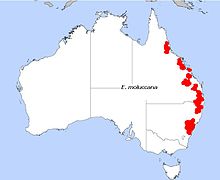Eucalyptus moluccana
| Eucalyptus moluccana | ||||||||||||
|---|---|---|---|---|---|---|---|---|---|---|---|---|

Eucalyptus moluccana |
||||||||||||
| Systematics | ||||||||||||
|
||||||||||||
| Scientific name | ||||||||||||
| Eucalyptus moluccana | ||||||||||||
| Roxb. |
Eucalyptus moluccana is a species ofthe myrtle family (Myrtaceae). It occurs on the east coast of Australia from north Queensland to the central coastline in New South Wales and is called there "Gray Box", "Coastal Gray Box" or "Gum-topped Box".
description
Appearance and leaf
Eucalyptus moluccana grows as a tree that reaches heights of up to 25 meters. The bark remains on the lower part of the trunk or on the entire trunk, is gray with white spots and fibrous-scaly. In the upper part of the tree it is smooth and gray and peels in short or long ribbons. The small branches are green. There are oil glands only in the marrow, not in the bark.
In Eucalyptus moluccana is Heterophyllie ago. The leaves on young specimens are ovate to circular and dull green. The 15 to 25 mm long leaf stalks are narrowly flattened or channel-shaped in cross section. The leaves on adult specimens are glossy green on the top and bottom and are lanceolate to ovate with a length of 8 to 14 cm and a width of 2.0 to 3.3 cm. with a pointed or blunt top and they taper towards the base. The lateral nerves are protruding, pointed and have large spacing.
Inflorescence and flower
On a 5 to 13 mm long inflorescence stem with a round or angular cross-section, there are approximately seven-flowered partial inflorescences in combined total inflorescences . The pedicel-round flower stalk is 1 to 7 mm long. The egg or spindle-shaped flower buds are 5 to 9 mm long and 3 to 4 mm in diameter. The calyptra is conical or beak-shaped, shorter than the flower cup (hypanthium) and as wide as this. It remains in place until the flower ( anthesis ) opens. All stamens are fertile (fertile).
fruit
The fruit is cylindrical or ovoid with a length of 5 to 9 mm and a diameter of 4 to 6 mm. The disc is indented and the fruit compartments are included.
Occurrence
Eucalyptus moluccana is found along the east coast of Australia from Queensland down to the area north of Nowra in the central coast of New South Wales.
Eucalyptus moluccana grows in grassy, sparse forests and is widespread, often even dominant, in these locations. The species prefers loamy soils with medium to high nutrient content. On the upper reaches of the Hunter River enters intergradation with Eucalyptus albens on.
Taxonomy
The first description of Eucalyptus moluccana was made in 1832 by the British botanist William Roxburgh in "Flora Indica; or descriptions of Indian Plants, Vol. 2, p. 298 “. The type material has the inscription "A native of the Molucca Islands". The specific epithet moluccana indicates the place where the type material was found, the Moluccas .
Synonyms for Eucalyptus moluccana Roxb. are Eucalyptus hemiphloia F.Muell. ex Benth. and Eucalyptus hemiphloia F. Muell. ex Benth. var. hemiphloia
There are no subspecies or varieties.
Individual evidence
- ↑ a b c d e f g h K. Hill: Eucalyptus moluccana (Roxb.) At New South Wales Flora Online . National Herbarium of NSW, Royal Botanic Garden, Sydney. Retrieved January 28, 2013
- ↑ Enter Eucalyptus moluccana in the search mask of the Australian Plant Common Name Database , Australian National Botanic Gardens . Retrieved January 28, 2013
- ↑ a b c Eucalyptus moluccana at EucaLink - A Web Guide to the Eucalypts . Retrieved January 28, 2013.
- ↑ a b c APNI = Australian Plant Name Index . Center for Plant Biodiversity Research. Australian Government. Retrieved January 28, 2013
- ↑ Rafaël Govaerts (ed.): Eucalyptus moluccana. In: World Checklist of Selected Plant Families (WCSP) - The Board of Trustees of the Royal Botanic Gardens, Kew . Retrieved January 28, 2013.

